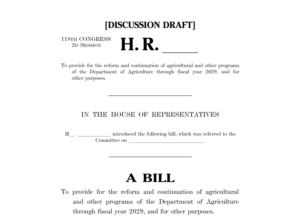House Republicans are planning to revive farm bill negotiations in January after failing to garner enough political will to pass a new deal by the end of the year, as…
House Unveils Farm Bill Text, Democrat Support Remains Uncertain
Politico’s Meredith Lee Hill reported this past Friday that “House Agriculture Chair G.T. Thompson’s long-awaited farm bill significantly boosts farm safety net programs but crosses two of Democratic leaders’ red lines, setting up a showdown with the Senate over the must-pass legislation.”
“In addition to major boosts in critical farm safety net program funding to support farmers reeling from grueling inflation, Thompson’s bill doubles key trade promotion to develop and support new markets for farmers to sell their products abroad,” Lee Hill reported. “It also increases funding for specialty crop programs, expands access to programs that lower energy costs for farmers and rural small businesses and improves tracking of farmland purchases by entities from China and other adversary countries.”
“The House bill also includes two of the major provisions that have drawn staunch opposition from senior Democrats,” Lee Hill reported. “One would limit future updates to the Thrifty Food Plan, which serves as the basis for calculating benefits from the Supplemental Nutrition Assistance Program, the nation’s largest anti-hunger program for low-income Americans.”

“The other provision many Democrats oppose removes strict climate-smart requirements for the use of roughly $13 billion in conservation funding from the Inflation Reduction Act when those dollars are incorporated into the farm bill for years to come,” Lee Hill reported. “The move represents a historic investment in farm conservation funding, but Democrats are pushing to keep the climate guardrails attached to the funding.”
Reference Prices Increase
Agri-Pulse’s Philip Brasher and Noah Wicks reported that “the 942-page bill, released Friday, would provide reference price increases for all row crops, with the rates varying depending on recent changes in markets and production costs.”
“The reference price for soybeans would go from $8.40 to $10 a bushel, an increase of more than 19%,” Brasher and Wicks reported. “The rate for corn would rise 10.8% from $3.70 to $4.10 a bushel.”
“Wheat growers would get an increase of 15.5% from $5.50 to $6.35,” they reported. “The reference price for seed cotton would increase 13.5% from 37 cents a pound to 42 cents a pound. Rice’s reference price would jump 20.7% from $14 a hundredweight to $16.90. The rate for sorghum would go up 11.3% from $3.95 to $4.40 a bushel. The reference price for peanuts would be increased 17.8% to $630 a ton.”
“To boost crop insurance coverage, the draft bill also would boost premium subsidies on the Supplemental Coverage Option from 65% to 80% and raise the top coverage level from 86% to 90%,” Brasher and Wicks reported.
Other Key Issues in the Proposed Bill
Agri-Pulse’s Wicks reported in a different article this past Friday that “the Conservation Reserve Program would undergo some major changes under House Agriculture Committee Republicans’ proposed farm bill draft, but they won’t be seen in the acreage cap, according to text unveiled today in preparation for a committee markup next week.”
“The proposal released today by House Republicans will maintain the current 27-million-acre cap on CRP,” Wicks reported. “Senate Agriculture Committee Chairwoman Debbie Stabenow’s framework, on the other hand, would gradually increase the program cap to 29 million acres.”
House Democrat Support Remains Uncertain
Lee Hill reported that “the release of the draft legislation marks the latest salvo in what has become an intensely partisan debate over food and agriculture policy, an issue area that has traditionally bridged the two parties. Democrats on the (House Ag) panel, however, have been under intense pressure from party leaders to not support Thompson’s House farm bill and to instead stand behind a rival proposal laid out by Senate Agriculture Chair Debbie Stabenow (D-Mich.), a member of Democratic leadership.”
“A group of frontline Democrats who serve on the Agriculture Committee met Thursday morning to consider how to approach the farm bill and ‘discuss policy options’ a day after senior Democrats pressed them to oppose the House bill in a closed-door meeting, according to two people familiar with the meeting who were granted anonymity to discuss the private conversations,” Lee Hill reported.
The House Ag Committee’s Ranking Member, David Scott, said in a press release this past Friday that “the discussion draft released by Chairman Thompson today confirms my worst fears: House Republicans plan to pay for the farm bill by taking food out of the mouths of America’s hungry children, restricting farmers from receiving the climate-smart conservation funding they so desperately need, and barring the USDA from providing financial assistance to farmers in times of crisis.”
Next Steps
The Hill’s Taylor Giorno reported Friday that the House Ag Committee is “set to mark up the multiyear package next week, but gaps between the Republican-controlled House version of the bill and summary of the Democrat-controlled Senate released earlier this month must be closed before Congress can pass the bill.”
“‘The release of this draft is a significant step forward in a years-long, deliberative process,’ G.T. Thompson said,” according to Giorno’s reporting. “‘The markup is one step in a greater House process, that should not be compromised by misleading arguments, false narratives, or edicts from the Senate. I look forward to engaging with colleagues on both sides of the aisle as we move to markup.’”
“The clock is ticking,” Giorno reported. “Congress has until Sept. 30 to come to a compromise and pass the bill or pass another extension.“





